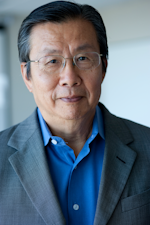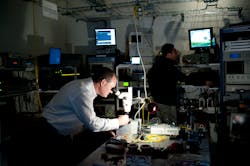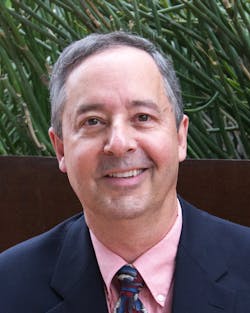Business Forum: Making things in academia: From telescope optics to nanophotonics
This month I interview Professor Tom Koch, who is Dean of the College of Optical Sciences at the University of Arizona (UA). (The acronym OSC is used as a reminder of its roots, the Optical Sciences Center.) Tom studied under the tutelage of Professor Amnon Yariv at Caltech after earning an A.B. from Princeton. He started his working career at Bell Labs, and rose to the position of Vice President of Technology Platforms at Lucent/Agere before moving into academia. The mission of the OSC is to conduct research and provide the state of Arizona and the nation with trained engineers and physicists in optical sciences.
Milton Chang: What attracted you to the UA?
Tom Koch: In addition to exceptional basic and applied optical physics, the college has a very strong program in optical engineering. This combination is unique, and only OSC and the Institute of Optics at the University of Rochester offer comprehensive graduate programs in optical engineering. These programs are on the front line in expanding optics applications into new areas for the nation and for the world. What also attracted me to OSC and UA was the culture of working on big projects. One of our hallmarks is being actively involved in making real stuff. The university as a whole has an appetite to work on big science.MC: Tell us about the college.
TK: The roots of the college go back to the astronomy and physics programs within our university. Early founders of the college emphasized fundamental breakthroughs in science and real-world applications, including working closely with industry and Nobel Prize winners working next to industry veterans. Our research programs span from optical engineering to fundamental optical physics and from photonics to image science, and provide unique opportunities to pursue cutting-edge applications of optics in real systems.
MC: I associate the University of Arizona with big telescope optics. Tell us more about what is going on.
TK: We’re certainly proud of our unique capabilities in very large optics, but our fabrication spans over nine orders of magnitude in size and we are the only place in the world that does that. We have e-beam lithography to make nanometer-scale features and photonics devices and, of course, we contribute to projects like the Giant Magellan Telescope using seven 8.4 m mirrors. In between, there is a growing effort in diamond turning and free-form micro-optics. These get used in everything from sensors to 3D vision systems for entertainment. Making things is part of the culture here of walking the talk—optics as a contact sport.
We are also working on image science, and UA is a real powerhouse in this area. This is really about integrating the design of imaging hardware with the mathematics of image information, and how to quantify that information to make decisions. And photonics is my own area. We lead the nation’s only NSF Engineering Research Center (ERC) on optical communications technology, called CIAN for the Center for Integrated Access Networks (www.cian-erc.org). CIAN is a 10-year funded program in research and education in optical fiber communications technology. We collaborate on this in a big team, including 10 universities and lots of companies: UCSD, NSU, Columbia, UCLA, Berkeley, Tuskegee, Cornell, USC, and Caltech. That’s quite a powerful team to drive advances in this field.
MC: Tell us more about CIAN.
TK: There is growing recognition that the Internet is really in the datacenters. One of the biggest challenges is increasing bandwidth while reducing power and size, requiring novelty in architectures and breakthroughs in photonic integration. Here in CIAN, we put together a research portfolio that addresses the entire food chain, all the way from fundamental materials and devices, nanophotonics, and lasers to new photonic-integrated circuit and subsystem technologies, up to new system architectures.
Another high-level question is how to develop physical hooks in the signaling and hardware to make more powerful autonomous intelligent networks, allowing automatic routing, regeneration, and bandwidth allocation at the transition from core networks into metro and local networks. CIAN is able to drive a natural conversation about technology and datacenters and have full-blown test beds to emulate datacenter and communication networks. So it is a very ambitious undertaking but provides a framework for really good research and education, and that is what NSF is all about.
MC: Wow! That is timely given the rate of bandwidth growth. Tell us more about imaging science, which is another technological area that is making significant strides.
TK: We reach into the life sciences community pretty strongly here, too. For example, at the Center for Gamma Ray Imaging, we are building innovative single-photon optics and imaging hardware. We use the techniques of nuclear medicine, which attach radioactive tracers to cancerous tissues, but develop new methods to image them with very high throughput and resolution.
Rather than having a single camera and scan, we use many cameras to simultaneously interrogate and develop homemade GPU clusters for data crunching. This is a very mathematical group, and while their focus had been medicine, they end up impacting everything from astronomy to remote sensing to homeland security.
MC: What is the overarching theme you are conveying?
TK: We want to keep the quality of research high and make powerful advances that will be valuable to the country. My goal is to really be at the top of our game in this broad portfolio of research, and continue to attract the best talent in the nation all the way from fundamental physics to the most practical engineering. I mentioned “big science”, and one example is the OSIRISREx project led by UA to land on the asteroid Bennu and bring a sample back to earth. That project is led by the Lunar and Planetary Lab and involves colleges across the campus. For example, there is a unique camera system for that mission that is being made by OSC. These are milestone-driven serious projects that get deployed, and we get to have our faculty and students involved.
It is the same with the big telescope and astronomy projects. Here in OSC we are finishing up the largest solar telescope that has ever been made, and that is going into an observatory on Mt. Haleakala on Maui. All these projects are very challenging in fabrication, metrology, mechanical, and system engineering, and there is collaboration across the campus to create these real, deployable things.
MC: What you describe is a great culture. There is no better way to educate students than getting them involved in real projects. What aspects or attitudes do you emphasize for your faculty and students?
TK: One of my goals is to expand this culture. Don’t just focus on writing papers. Focus on a full system demonstration if you really believe in what you are doing. If you lack some equipment or skills, you can dial other individuals on campus into your proposal to do these ambitious things. If you want to do something in life sciences instrumentation, then demonstrate its efficacy in a real operating theater in the medical school. I’d like to get more people to think about system-level work.
My heritage is Bell Labs, where we had the opportunity to work on real-world industry problems. This provided a problem-rich environment where you’re often the first one confronting a really important barrier that nobody understands. Suddenly, you can be the first one to research and understand a problem that other people don’t even yet know about, giving you a great opportunity to have a lot of impact.
This conversation will continue in the August 2015 issue of Laser Focus World.

Milton Chang
MILTON CHANG of Incubic Management was president of Newport and New Focus. He is currently director of mBio Diagnostics and Aurrion; a trustee of Caltech; a member of the SEC Advisory Committee on Small and Emerging Companies; and serves on advisory boards and mentors entrepreneurs. Chang is a Fellow of IEEE, OSA, and LIA. Direct your business, management, and career questions to him at [email protected], and check out his book Toward Entrepreneurship at www.miltonchang.com.

